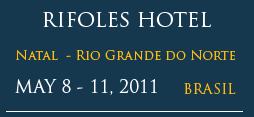

LOCATION
CITY OF NATAL
Natal, the Capital of Rio Grande do Norte, Brazil
Natal with its 365 days of an average temperature of 26 C is a popular tourist destination. Natal in Rio Grande do Norte is one of Brazil’s most privileged and popular cities. Rio Grande do Norte has approximately 400 km of coastline, blessed with some of the most beautiful beaches in Brazil like Pium and Cotovelo in the south and to the North separated by the Potengi and Natal rivers you have the wonderful beaches of Redinha and Genipabu with their shifting dunes, warm, clear water, lakes and coconut groves which attract both Brazilian and foreign tourists all year round.
Despite all this beautiful coastline, tourism in Rio Grande do Norte only really took off in the 1980’s in the state’s capital Natal, the construction of the “Via Costeira”, an eight-kilometre avenue running along the coast where lies the city's main hotels and restaurants. Since that time the government has been investing heavily in the state’s infrastructure, tourism and cultural heritage.
Rio Grande do Norte has also been inducted in the Guinness Book of Records, a 92 year-old cashew tree, which can be found on the beach in “Pirangi do Norte”, which is located 24 km from Natal, it is the world's largest cashew tree it has a circumference of some staggering 500 meters! Occupying an area of 7,300 m2. Its branches are equivalent to 70 cashew trees yet it is just one single tree.
The city Natal was originated on Forte dos Reis Magos (Reis Magos Fort). On December 25th, 1599, the Portuguese arrived in Rio Grande do Norte to expel the French that were conquered that part of the coastline. And on the mouth of the Potengi river, they started to rise up a fort to protect the territory. Now that fort is one of the most popular attractions by the tourists.
It’s simple to convey why: Natal has beautiful beaches, blue and warm sea, dunes and sun the all year round. Besides that, it has an excellent infrastructure for hosting visitors. In the Via Costeira, an avenue that borders some of its beaches, there’s an array of resorts and good hotels, offering plenty of comfort and leisure. Nearby, on the Ponta Negra beach, there are hundreds of small, simple and cosy inns.
Natal is also known for its dune buggies, restaurants, sport fishing and artisans. The city nightlife is great, on the bars of Ponta Negra beach and in the forrós.
Natal’s coastline is divided into TWO areas (North and South) by the river (Delta) into the sea. It currently takes 30 to 40 min to drive around the delta; the State is currently building a bridge to connect the north and the south. .
Ponta Negra is the most visited beach, good for sunbathing and swimming. At the end of the beach lies“Morro do Careca” (Bald Hill), an enormous dune more than 100 meters high. The Via Costeira has resorts and hotels. On some legs of that beach, it’s difficult entering on the sea because the presence of reefs. To the north, the urban beaches of “Areia Preta” “Artistas” and “Meio”, where there are bars and small hotels. Near to the mouth of the Pontegi river, the Forte beach, where is the Forte dos Reis Magos.
It’s possible to visit some places near Natal and its attractions. On Genipabu, 25 km from Natal, there are enormous dunes and lakes that are part of the dune buggy attraction. From Pirangi do Norte, 30 km from Natal, boats leave for the natural pools formed when the tide is low.
The second largest urban park in Brazil, with about 1200 ha, has a big reserve of Atlantic Forest vegetation. It has trails.
Resorts and hotels at the seacoast and inns compose a lot of accommodation options around the city. The city has restaurants that serve regional dishes, from seafood to specialties. There is a great number of reception tourism agencies, besides car rental agencies.
Natal is on the northeast region. It is 2500 km from Brasilia and 2660 km from Rio de Janeiro. Augusto Severo airport, 15 km from the city center, operates with flights from and to the main cities in the country. At the bus depot, buses arrive from all regions of Brazil.














